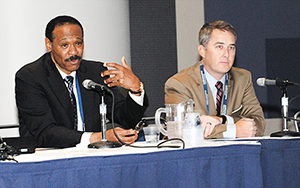
Keith A. (Tony) Jones, M.D., (left) and Jeff Simmons, M.D., answer questions from the audience about the implementation of a PSH.
Implementing a perioperative surgical home can be a challenge, but UAB Hospital at the University of Alabama at Birmingham has had success with its efforts, which were reviewed by three team members Saturday during “Challenges in Implementation of the Perioperative Surgical Home.”
An important first step in a successful implementation is to get support from the hospital, physician specialties and the variety of professionals who will be part of the PSH team.
“It needs to be driven from the institution down,” said Keith A. (Tony) Jones, M.D., the Alfred Habeeb Professor and Chair of the UAB Department of Anesthesiology and Perioperative Medicine. “We have incorporated this into the ValUABle Care Initiative.”
The initiative’s committee was chaired by heads of anesthesiology and surgery with a focus on treating colorectal cancer patients
Jeff Simmons, M.D., Associate Professor of Anesthesiology at UAB, discussed the recruitment of the first surgical service in the initiative. A key was establishing a sense of urgency, which was managed by providing historical data that showed a need for improved outcomes.
“You also need clinical champions,” he said, starting with executives, department chairs and vice chairs, and other health care professionals. “They need to understand the plan to effect the protocols. You need to have the nurses, the pharmacists and others on board. You cannot have a 30,000-foot view and get protocols implemented on the floor.”
Team members met at the start of the process to develop lead practice guidelines, and 80 were developed for colorectal cancer treatment so the best guidelines for each patient could be determined.
In the months before the initiative was implemented, information was communicated to all involved through educational fliers, and promoted with posters and billboards. After the first 50 patients were treated, emails were sent to team members asking if they saw barriers to successful enhanced recovery, getting those team members even more involved in the process, Dr. Simmons said.
Other keys were to immediately promote the initiative’s early successes to groups outside the colorectal cancer team and to continue to ask for feedback from team members using Survey Monkey.
“It is easy to show value to the hospital. This is standardization of care,” Dr. Simmons said. “It is easy to show efficiency and value using these types of processes.”
It also was important to gain support among anesthesiologists, said Arthur M. Boudreaux, M.D., Professor of Anesthesiology at UAB, who said that including experienced anesthesiologists in the entire process is vital.
“If we ask you to change the way you do business and don’t ask your opinion, you don’t get buy-in,” he said. “Many colleagues are experts in the specialty and it is offensive if you don’t include them.”
Two key concepts emphasized were that staff members have two jobs — doing work and improving work. Work is a process that can be studied and improved, and variation produces waste and error, Dr. Boudreaux said.
“The perioperative surgical home is a performance improvement and a change management effort,” he said, discussing how data was collected and shared to prove best processes. All information was available on a dashboard, including compliance data for physicians.
“The dashboard also has forms to solicit comments so people have a mechanism to post disagreement or suggestions to protocols, and those are reviewed by the team,” Dr. Boudreaux said.
Return to Archive Index